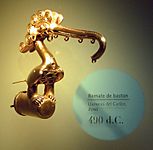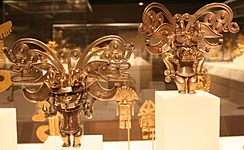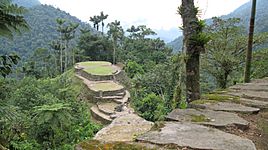Indigenous peoples in Colombia facts for kids
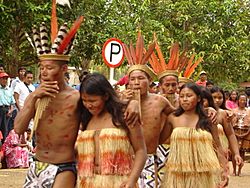
The Piratapuyo People doing ritual dances in the streets of Mitú
|
|
| Total population | |
|---|---|
| 1,905,617 (2018 Census) 4.4% of Colombia's population 1%, 1.8%, 2%, 4% or 10% of Colombians (external sources) |
|
| Regions with significant populations | |
| Throughout the country, especially in Andean Highlands, Caribbean Region and Amazonía Region | |
| Languages | |
| Indigenous languages and Spanish | |
| Religion | |
| Roman Catholicism, Evangelicalism, Native American religions |
Indigenous peoples are the first people who lived in Colombia, long before Europeans arrived in the 1500s. They are also called Native Americans or Amerindians. Today, about 4.4% of Colombia's population are Indigenous, belonging to 115 different groups.
Many Indigenous people live in areas like La Guajira, Cauca, and Nariño. The Amazon rainforest, though not many people live there, is home to over 70 different Indigenous groups.
Contents
A Look at Early History
Scientists believe the first people arrived in South America around 15,000 BC. Early hunter-gatherers lived in Colombia around 10,000 BC. These early groups lived along the Caribbean coast and in the Andes mountains. One of the oldest known sites where people lived is Tibitó, near Bogotá, dating back to about 9,790 BC. By 2,000 BC, permanent villages were built in northern Colombia.
Ancient Civilizations of Colombia
Around 1,000 BC, several Indigenous groups became very skilled. These included the Muisca, Quimbaya, Tairona, and Zenú. They learned how to farm, mine, and create beautiful metal objects. Some groups also developed a political system called cacicazgos. In this system, a powerful leader called a cacique was in charge.
When the Spanish arrived in 1509, they found many different Indigenous groups. There were between 1.5 million and 2 million people, speaking hundreds of different languages. The most advanced groups were the Muisca and Tairona. They were part of the Chibcha group.
The Muisca people lived mainly in the Cundinamarca and Boyacá areas. They had moved there centuries earlier to escape warlike groups like the Caribs. The Taironas lived in the Caribbean lowlands and the Sierra Nevada de Santa Marta mountains. The Muisca had a well-organized society with laws and powerful caciques. These leaders reported to two supreme leaders.
- Pre-Columbian Art and Sites
-
The zipa (a Muisca leader) would cover himself in gold. From his Muisca raft, he offered treasures to a goddess in a sacred lake. This tradition led to the famous El Dorado legend.
-
A golden bird ornament from the lowland Zenú culture, made around 490 CE. The Zenú were known for their gold work.
-
Tairona pendants made of gold.
-
A golden statue of a Quimbaya cacique (leader).
-
San Agustín Archaeological Park is a UNESCO World Heritage Site. It has the largest collection of religious monuments and large stone sculptures in Latin America. It is considered the world's largest ancient burial ground.
-
Ciudad Perdida (Lost City) was founded around 800 CE. It has 169 terraces carved into the mountain, stone roads, and small circular plazas. To reach it, you must climb about 1,200 stone steps through the jungle.
Life Before Europeans Arrived
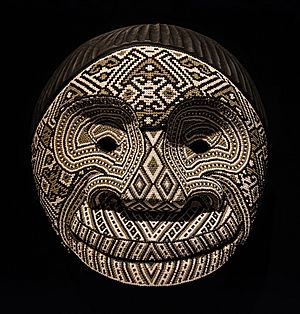
Indigenous groups had many different ways of life. Some lived in farming chiefdoms with clear social classes. Others lived in farm villages or were nomadic hunter-gatherers. By the end of the colonial period, Indigenous people still made up about half of Colombia's population.
In the highlands, the Spanish created systems to control Indigenous people and their labor. By the late 1500s, they had set up political and religious rule. They also began trying to convert Indigenous people to Christianity.
The most important system for highland Indigenous people was the resguardo. This was a reservation system where land was owned by the community. Indigenous people could use the land but could not sell it. This system is still in place today, though it has changed over time. However, as more people needed land, settlers often moved onto resguardo lands.
For Indigenous people in the forests, Catholic missions often had control during the colonial period. The government supported these missions to teach and convert the lowland tribes.
Indigenous Rights and Territories
The struggle for Indigenous rights continued into the late 20th century. The Colombian Constitution of 1991 brought many changes. It recognized many Indigenous demands. New resguardos were created, and others were strengthened.
The 1991 constitution created special political and social opportunities for Indigenous groups. For example, it allowed for a special commission to help Black communities on the Pacific Coast. It also gave Indigenous people special representation in the Senate and the Chamber of Representatives. This means they have a voice in the government. The constitution also protects Indigenous land and cultural rights.
By 1991, Colombia had 587 resguardos, home to over 800,000 people. These lands covered about 24% of Colombia's total area. Today, there might be as many as 710 resguardos across 27 of Colombia's 32 departments.
Indigenous Political Groups
Different Indigenous groups have their own ways of governing themselves. Many groups are represented by the National Indigenous Organization of Colombia (ONIC). Over the last 40 years, Indigenous groups have become more organized. This has helped them gain more land. From 1960 to 1990, the government recognized over 200 new reserves. By 1997, 334 of these operated as self-governing areas.
Indigenous Territories in Colombia
Indigenous peoples own large parts of Colombia, mainly through Indigenous Reserves (resguardos). These reserves cover about one-third of the country's land. The Ministry of Interior lists 567 reserves, covering about 365,000 square kilometers. These are home to over 800,000 people.
The 1991 Constitution defined Indigenous Territories as special areas. Within these areas, Indigenous people can manage their own affairs. They can also manage resources and collect taxes to support their communities. However, the law to fully define these territories has not yet been passed. This means that in practice, these territories are not fully regulated.
Main Indigenous Groups
According to the National Indigenous Organization of Colombia (ONIC), there are 102 Indigenous groups in Colombia. The largest groups are the Wayuu (380,460 people), Zenú (307,091), Nasa (243,176), and Pastos (163,873). These four groups make up over half of Colombia's Indigenous population.
Indigenous groups are often divided into "highland peoples" and "lowland peoples." Highland peoples live in the Andes mountains and the Sierra Nevada de Santa Marta. Lowland peoples live in areas like Chocó, the Amazon, Guajira, and the Caribbean Coast.
Highland Peoples
Lowland Peoples
- Achagua
- Amorúa
- Andaquí
- Andoque
- Bara
- Barasana
- Barí/Motilon
- Betoye
- Bora
- Cabiyarí
- Carapana
- Carijona
- Catío
- Cocama/Kokama
- Cofán/Kofán
- Coreguaje
- Cubeo
- Cuiba
- Curripaco
- Chimila
- Chiricoa
- Desano
- Emberá
- Guahibo (Sikuani)
- Guayabero
- Guayupe
- Kuna (Tule)
- Kokama
- Hupda
- Letuama
- Makaguaje
- Makuna
- Masiguare
- Mvatapí
- Miraña
- Mokaná
- Muinane
- Muzo
- Nonuya
- Nukak
- Ocaína
- Piapoco
- Piaroa
- Piratapuyo
- Pitsamira
- Puinave
- Sáliba
- Siona
- Siriano
- Taiwano
- Tanimuka
- Tariano
- Tatuyo
- Tikuna
- Tukano
- Tuyuca
- Wounaan
- Wanano
- Wayuú
- Witoto/Huitoto/Uitoto
- Yagua
- Yarigui
- Yukuna
- Yukpa/Yuko
- Yuri
- Yurutí
- Zenú
Challenges and Progress
Indigenous people make up a small part of Colombia's population. They often face challenges with income, education, and health. In recent years, there has been more interest in helping Indigenous communities worldwide. The United Nations even declared an "International Decade of the World's Indigenous People."
In Latin America, Indigenous movements have grown stronger. They have gained more political power. This rise in Indigenous action in Colombia comes from several issues. These include a lack of proper representation in government and not enough chances for citizens to participate. There is also a history of discrimination against some social groups.
Indigenous groups have moved away from armed conflict. Instead, they use legal and political ways to gain recognition and respect. However, this has not always been easy. They have sometimes faced more persecution and violations of their rights.
The National Indigenous Organization of Colombia (ONIC) states there are 102 Indigenous groups in Colombia. But only 82 are officially recognized by the government. A big problem is that the government often does not consult Indigenous communities on decisions that affect them.
Poverty is another major issue. Many Indigenous communities live in areas with high levels of poverty. These include Chocó, Sucre, Boyacá, Nariño, and Córdoba. In the past, government programs tried to "modernize" Indigenous communities. But Indigenous groups argued that the state needed to change its ideas and recognize them as the original people of Colombia.
The goal was to solve problems by reducing poverty. This also meant respecting local needs and different cultures. However, Indigenous people were often seen as "disadvantaged" groups that needed to be "integrated" into society. This idea has existed since colonization: that Indigenous and Black cultures are negative and should be removed for "development."
Despite the 1991 Constitution, which recognized Colombia as a multi-ethnic and multicultural nation, the relationship between the government and Indigenous communities can be difficult. Indigenous groups want more self-rule. The government sees them as "communities" that need special treatment to fit into national society. They have been given some ways to participate, but always within the state's rules.
Even with progress in the 1990s, Indigenous people realize that simply being recognized as "equal" is not enough. They also demand their right to be different. This means having specific rights as Indigenous communities. Today, Indigenous political participation in elections is still low. This is due to many factors, including the many different groups within the Indigenous movement and the fact that many live in rural areas with limited voting access.
See also
 In Spanish: Población indígena de Colombia para niños
In Spanish: Población indígena de Colombia para niños
- Pre-Columbian cultures of Colombia
- Spanish conquest of the Muisca
- Spanish conquest of the Chibchan Nations
- Indigenous peoples of South America
- National Indigenous Organization of Colombia (ONIC)
- Colombian mythology
- Colombian folklore
- Archaeological sites in Colombia
- Race and ethnicity in Colombia
- Mestizo Colombians
- Concordat of 1928
Images for kids



